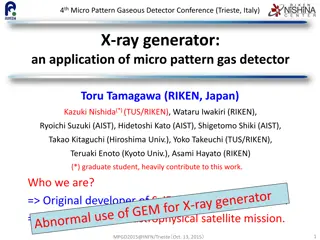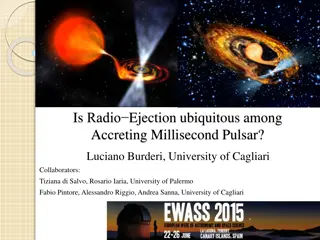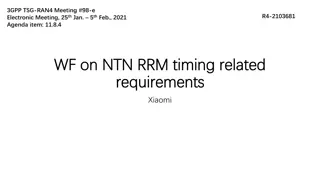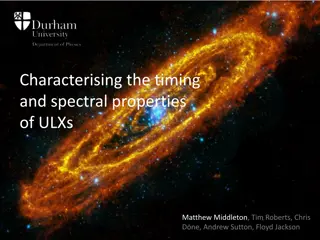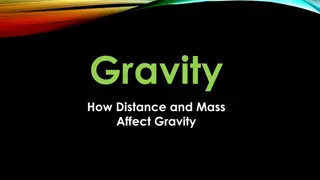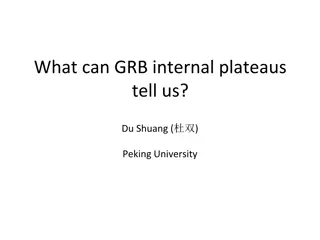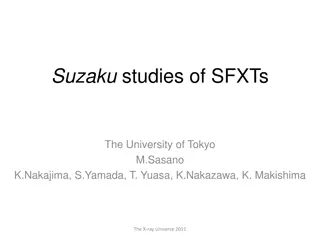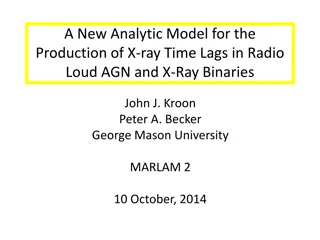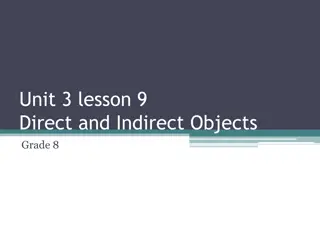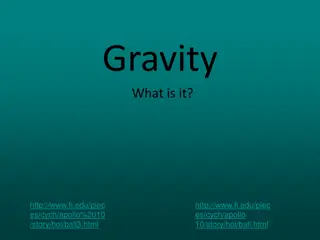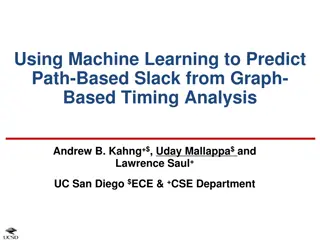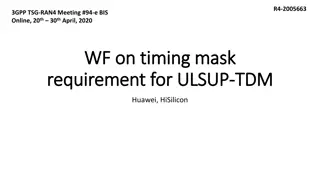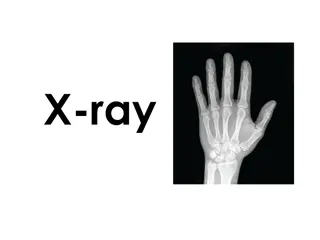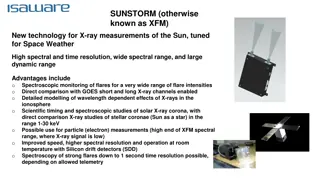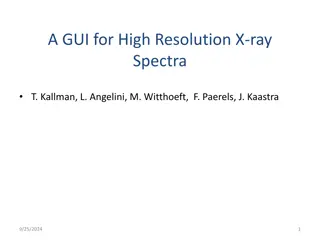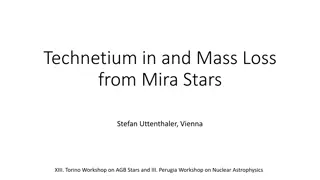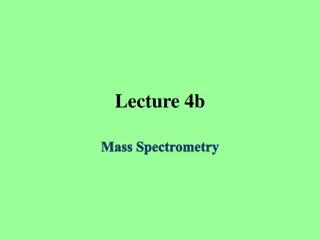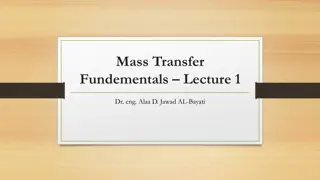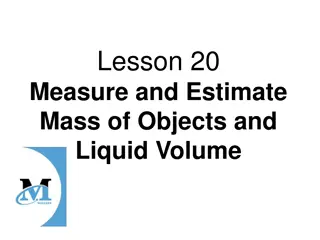Insights into X-ray Timing and Mass of Accreting Compact Objects
The study explores the variability and high-frequency QPOs of accreting compact objects, providing a unique opportunity to probe effects in strong gravitational fields. It delves into the properties of neutron stars and the explanations for HF QPO phenomenon related to orbital motion in strong gravity, highlighting valuable insights into physical behavior in extreme environments.
Download Presentation

Please find below an Image/Link to download the presentation.
The content on the website is provided AS IS for your information and personal use only. It may not be sold, licensed, or shared on other websites without obtaining consent from the author. Download presentation by click this link. If you encounter any issues during the download, it is possible that the publisher has removed the file from their server.
E N D
Presentation Transcript
X-ray timing and mass of accreting compact objects Gabriel T r k Institute of Physics, Research Centre for Computational Physics and Data Analysis, Silesian University in Opava, Czech Republic
X-ray timing and mass of accreting compact objects Part II: The final formula Gabriel T r k Institute of Physics, Research Centre for Computational Physics and Data Analysis, Silesian University in Opava, Czech Republic
X-ray timing and mass of accreting compact objects Polish doughnuts are tasty Gabriel T r k Institute of Physics, Research Centre for Computational Physics and Data Analysis, Silesian University in Opava, Czech Republic
1. Variability of accreting compact objects, HF QPOs and GR LMXBs provide a unique chance to probe effects in the strong-gravity-field region. The way how electromagnetic radiation propagates in space, its time variability and shape of lines in its energetic spectrum are invaluable probes to physical behavior of the matter in strong gravitational field. Similarly, a systematic study of the properties of neutron stars allows us to explore supradense matter. Testing Supra-dense matter RXTE HF QPOs
1. Variability of accreting compact objects, HF QPOs and GR The high-frequency QPOs are observed in both BH and NS sources and span frequency range of tens to more than thousands of hertz. Their frequencies correspond to orbital frequencies in innermost parts of the accretion disk. HF QPOs a BHs NSs
1. Variability of accreting compact objects, HF QPOs and GR There is a large variety of ideas proposed to explain the QPO phenomenon. Most often the QPOs are related to orbital motion in strong gravity. Indeed, the QPO frequencies (seem to) follow relativistic 1/M scaling. cca 1Msun NSs Goluchova et al. 2019, A&A Letters
1. Variability of accreting compact objects, HF QPOs and GR There is a large variety of ideas proposed to explain the HF QPO phenomenon. Most often the QPOs are related to orbital motion in strong gravity. Global oscillations ER model (Abramowicz & Kluzniak), p-modes, c-modes, (Wagoner, Rezzolla, Kato, Done ), . Local oscillations RP model (Stella), TD model (Cadez), . RP TD
1. Variability of accreting compact objects, HF QPOs and GR In the following we focus namely on Keplerian motion and Relativistic preccesion model (RP model) Axisymmetric epicyclic modes (m=0 radial and vertical) Combinations of non-axisymmetric epicyclic modes that may serve as a plausible alternative to RP model (amplitudes, coherence, modulation etc.) ER RP TD
2. BH QPOs and epicyclic modes in non-slender torus https://arxiv.org/abs/2008.12963 Kotrlova et al. 2020, A&A We explore the influence of non-geodesic pressure forces that are present in an accretion disk on the frequencies of its epicyclic oscillation modes. We discuss its implications for models of QPOs in the three Galactic microquasars. We focus on previously considered QPO models that deal with low azimuthal number epicyclic modes and outline the consequences for the estimations of BH spin.
2. BH QPOs and epicyclic modes in non-slender torus https://arxiv.org/abs/2008.12963 Kotrlova et al. 2020, A&A We explore the influence of non-geodesic pressure forces that are present in an accretion disk on the frequencies of its epicyclic oscillation modes. We discuss its implications for models of QPOs in the three Galactic microquasars. We focus on previously considered QPO models that deal with low azimuthal number epicyclic modes and outline the consequences for the estimations of BH spin.
2. BH QPOs and epicyclic modes in non-slender torus The CT model has been suggested as the RP model alternative which deals with torus oscillations. It is based on the expectation that cusp configurations are likely to appear in real accretion flows, in which case the actual overall accretion rate through the inner edge of the disk can be strongly modulated by the disk oscillations. + Keplerian motion. We focus on previously considered QPO models that deal with low azimuthal number epicyclic modes: Axisymmetric epicyclic modes (m=0 radial and vertical). Combinations of non-axisymmetric epicyclic modes. Main approximation: Polish dougnats (constant ell, i.e. the opposite extremum than Keplerian ell).
2. BH QPOs and epicyclic modes in non-slender torus https://arxiv.org/abs/2008.12963 Kotrlova et al. 2020, A&A
2. BH QPOs and epicyclic modes in non-slender torus Favoured models Kotrlova et al. 2020, A&A The model considering axisymmetric modes implies high BH spins (the same conclusion as in the geodesic case). The model alternative to relativistic preccesion model (CT model) imlies moderate BH spins.
3. NS QPOs and epicyclic modes in non-slender torus (CT model) The CT model has been suggested as the RP model alternative which deals with torus oscillations. It is based on the expectation that cusp configurations are likely to appear in real accretion flows, in which case the actual overall accretion rate through the inner edge of the disk can be strongly modulated by the disk oscillations. Mode identification: non-axisymmetric modes, Keplerian motion. Main approximation: Polish dougnats (constant ell, i.e. the opposite extremum than Keplerian ell).
3. NS QPOs and epicyclic modes in non-slender torus (CT model) The CT model provides generally better fits of the NS data than the RP model. It also predicts a lower NS mass than the RP model which, in some cases, implies a mass estimate that is too high. Torok et al, 2016, 2018, 2019, MNRAS Mass/solar mass
4. CT model - simple analytic formula relating the mass and spin The relation between QPO frequencies predicted by CT model are implicitly given by a long set of formulae that have to be solved numericaly (even for non-rotating stars, j=0). BUT there is a very accurate approximation. Where we assume j=0 and B=0 corresponds to the exact prediction of RP model while B=0.8 well mimics the CT model prediction.
4. CT model - simple analytic formula relating the mass and spin For rotating stars B=0 corresponds to the exact prediction of RP model. And one can expect there is some B=B(a) appropriate to the CT model. The simplest choice is: We find that k=0.2 provides predictions in agreement with numerical solution calculated for the CT model.
4. CT model - simple analytic formula relating the mass and spin Torok et al, 2020, in prep.
4. CT model - simple analytic formula relating the mass and spin Torok et al, 2020, in prep. Caveats: - BHs or high mass NSs - spins below a=0.9 - constant ell (the flow)
5. CONCLUSIONS Torok et al, 2020, in prep. Polish doughnuts are tasty



